Abstract
As the problems of electromagnetic pollution and interference are becoming increasingly serious, the development of electromagnetic absorption materials with a high absorption capacity and broad absorption bandwidth are stringently needed. In this work, an N-doped 2D carbon/Ni complex is synthesized through direct microwave irradiation on a mixed solution of nickel nitrate, urea, and agarose under N2. The electromagnetic absorption performance can be tuned by controlling the Ni content. Specifically, minimum reflection loss values (RLmin) of −65.5 dB at 15.8 GHz with an effective absorption bandwidth (EAB) of 4.2 GHz at a sample thickness of 1.47 mm, and −55.4 dB at 11.8 GHz with an EAB of 3 GHz at a sample thickness of 1.92 mm can be obtained. The outstanding performance of electromagnetic absorption is attributed to the multiple polarization relaxation processes and the synergistic effect between 2D carbon sheets and Ni particles.
1. Introduction
The rapid development of wireless communication has brought great convenience to people’s lives. The problem that follows is that the use of large-scale electronic equipment will inevitably bring serious electromagnetic pollution and interference. In order to solve these problems, it is necessary to develop materials with broadband and high electromagnetic absorption characteristics [1,2,3,4,5,6]. This requires the impedance of the material to be well matched with that of the air in a wider frequency band to ensure electromagnetic waves enter the material so that less electromagnetic energy is reflected. At the same time, the material should have a strong electromagnetic attenuation capability to prevent electromagnetic wave from penetrating the material. Absolutely, compared with material with a single loss mechanism, the material with both dielectric loss and magnetic loss has obvious advantages due to its better impedance matching and diverse loss mechanisms.
Carbonaceous materials have always been the most popular electromagnetic absorbing materials because of their adjustable performance, relatively low density, abundant resources, convenient preparation, and low cost [7,8,9,10,11,12]. Compared with oxides, the soft magnetic metals Ni and Co have higher magnetization, which leads to high Snoek limit and magnetic permeability in the high-frequency region, resulting in strong magnetic loss [13]. However, Ni and Co can be easily oxidized, resulting in a decrease of their magnetization, which directly affects the absorbing performance [14]. In the composite of magnetic metal and carbon material, the presence of carbon material can prevent the oxidation of the magnetic metal, and the magnetic metal helps impedance matching. Therefore, carbon/metal nanoparticle composites with excellent dielectric loss and good magnetic loss have become a hot spot for electromagnetic absorbing materials in recent years. Specifically, 2D nanosheet structure and N-doping in the carbon were regarded to be quite beneficial in obtaining enhanced performance. For example, Xu et al. [15] synthesized 1D/2D hierarchical Co/N-decorated carbon architecture through sintering the precursor compound at 700 °C for 2 h with the rate of 2 °C min−1 in the N2 atmosphere, showing the RLmin of −44.6 dB at 5.2 GHz with a low filler loading of 15 wt% and the thickness of 1.5 mm. However, the corresponding RL < −10 dB effective absorption bandwidth (EAB) was only about 1.8 GHz. Yuan et al. [16] treated the mixture of urea and nickel acetylacetonate (molar ratio of 6:1) at 900 °C for 1 h under Ar atmosphere and soaked the products in 0.5 M H2SO4 at 160 °C for 12 h to obtain an Ni particle encapsulated in few-layer N-doped graphene, which exhibited the RLmin of about −23 dB at 12 GHz. The corresponding EAB was 8.5 GHz. Those methods involved long periods of high temperature treatment, consuming a lot of energy, which was mismatched with green chemistry theory.
Recently, microwave-assisted synthesis of advanced materials has attracted widespread attention due to a variety of advantages such as efficient heating mechanism, enhancing material quality, adjusting material morphology and so on [17,18,19,20,21,22,23,24]. Voiry et al. [17] put the mildly reduced graphene oxide into microwave oven at 1000 W for 2 s under Ar to synthesize the high-quality graphene, which exhibited highly ordered atomic structure compared to the disordered structure with holes and oxygen functional groups on the surface of graphene prepared by conventional thermal reduction process. Zhou et al. [20] realized the precise controllable synthesis of 3D flower-on-sheet nanostructured nickel cobalt double hydroxide and applied it in supercapacitors, showing excellent energy storage performance.
In this work, N-doped 2D carbon/Ni composites (NC/Ni) were synthesized through a one-step microwave irradiation process based on the coordination between agarose and Ni2+. The electromagnetic parameters of the material can be effectively optimized by adjusting the amount of Ni content. The NC/Ni displays excellent absorbing properties of electromagnetic wave, meeting the practical application requirements.
2. Materials and Methods
2.1. Material
Urea (99%) and agarose were purchased from Shanghai Aladdin Chemical Corporation. Ni(NO3)2·6H2O (98.0%) was purchased from Sinopharm Chemical Reagent.
2.2. Method
2.2.1. Synthesis Process
Agarose (2 g) and urea (0.5 g) were added into a 15 mL Ni(NO3)2 solution of different concentrations (0.25 M, 0.5 M, 0.75 M, 1 M). The mixture was then placed in a commercial microwave oven (Galanz, G90F23CN3PV-BM1, Foshan, China) and irradiated for 30 s at the power of 900 W. During this stage, agarose was melted into a homogenous liquid. Then, the gel was continued to be irradiated under a microwave power of 900 W for 8 min, yielding the final product, which was grounded in a mortar followed by passing through a 200-mesh sieve. The products derived from different Ni(NO3)2 concentrations were labeled as NC/Ni-0.25M, NC/Ni-0.5M, NC/Ni-0.75M and NC/Ni-1M, respectively.
2.2.2. Characterization
The chemical composition of the prepared samples was recorded on X-ray diffractometry (XRD). Field emission scanning electron microscope (FESEM, AZtec X-Max 50, Oxford, UK) and transmission electron microscope (TEM, FEI Talos F200X, Hillsboro, OR, USA) were used to analyze the microstructure. X-ray photoelectron spectroscopy (XPS) data were obtained on a Thermo escalab 250Xi system (Waltham, MA, USA). Raman spectra were measured on a laser Raman spectrometer LabRAM HR (Horiba, Paris, France) with a 532.17 nm laser. The complex relative permittivity and permeability of products were measured on an Agilent E8363C vector network analyzer (Agilent, Palo Alto, CA,USA) equipped with a coaxial fixture (Φout = 7.00 mm, Φin = 3.04 mm) in the frequency range of 2.0–18.0 GHz, where the samples composed of 50% product and 50% paraffin wax was pressed into a ring clamp with the pressure of 1 Mpa for 1 min.
3. Results and Discussion
The XRD spectra of the four samples are shown in Figure 1a. As can be seen, characteristic peaks located at 44.5°, 51.8°, 76.4° corresponding to metallic Ni (PDF 1-1258) were observed for all samples. The intensities of the peaks became stronger with the increase of Ni content. Besides, the appearance of a weak peak around 26° indicated that the agarose has been converted to partially graphitized carbon under the microwave radiation. In Raman spectra of the samples (Figure 1b), two obvious peaks were observed at around 1340 and 1590 cm−1, corresponding to the D band and G band of carbon, respectively, which was consistent with the XRD result. The ratios of the intensity of D band to that of G band (ID/IG) describing the degree of structural defects in carbon materials were 1.52 for NC/Ni-0.25M, 1.01 for NC/Ni-0.5M, 0.99 for NC/Ni-0.75M and 1.11 for NC/Ni-1M, respectively, suggesting that there were the most structural defects in NC/Ni-0.25M [25]. In addition, the present of the 2D band at around 2670 cm−1 in Raman spectra for NC/Ni-0.25M and NC/Ni-0.5M implied the formation of 2D carbon sheets. As widely reported in the literature, Ni particles can catalyze the formation of graphitized carbon. Therefore, with the increase of Ni content, the intensity for peak G of carbon became stronger, indicating less structural defects. However, when the Ni content was too high, it would bring certain structural defects probably due to the introduction of some holey structure in the carbon matrix [21]. Figure 1c exhibits the XPS full spectra of the four samples, demonstrating successful doping of N in carbon. The contents of N were 4.1 wt% for NC/Ni-0.25M, 2.5 wt% for NC/Ni-0.5M, 2.1 wt% for NC/Ni-0.75M and 1.4 wt% for NC/Ni-1M. The N 1s spectrum of NC/Ni-0.25M could be deconvoluted into three peaks at 400.8 eV (graphitic-N), 399.4 eV (pyrrolic-N) and 398.6 eV (pyridinic-N) (Figure 1c insert), indicating that N atoms were effectively bonded to the carbon atoms, which was beneficial to the formation of dipole and further effectively enhance the polarization loss [26,27]. The existence of elemental O in the XPS full spectra was probably derived from the oxidation of Ni on the surface to NiO.

Figure 1.
(a) The XRD, (b) Raman spectra and (c) XPS spectra of the four as-prepared NC/Ni products (the insert in (c) is N 1s XPS spectrum of NC/Ni-0.25M).
Figure 2 shows the morphology of the four NC/Ni samples. NC/Ni-0.25M displayed 2D structure with Ni particles embedded in the porous carbon sheets about 300 nm thick. The porous structure was conducive to attenuation of electromagnetic wave due to multiple reflections inside the holes. With the increase of Ni nanoparticles, the 2D porous carbon structure gradually disappeared. Specifically, the carbon in NC/Ni-1M clumped together and formed a disorganized structure (Figure 2d). NC/Ni-0.25M was examined under TEM as a representative. Figure 3a shows that Ni nanoparticles were uniformly distributed in the carbon nanosheet matrix. Figure 3b,c show that the Ni nanoparticles were about 10–20 nm in diameter. The lattice fringe of 0.20 nm and 0.18 nm corresponded to the (111) plane and (200) plane of nickel, respectively. Besides, lattice spacings of 0.34 nm attributed to graphitized carbon were also observed.
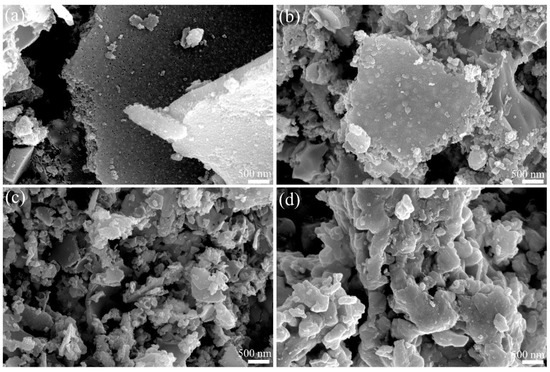
Figure 2.
FESEM images of (a) NC/Ni-0.25M, (b) NC/Ni-0.5M, (c) NC/Ni-0.75M, (d) NC/Ni-1M.
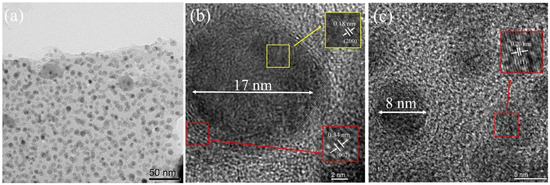
Figure 3.
TEM images of NC/Ni-0.25M at different magnifications (a–c).
Based on the theory of transmission line, the electromagnetic wave absorbing properties of the NC/Ni samples were assessed by the reflection loss (RL) value which was calculated from the relative complex permittivity () and permeability () of the products in the frequency range of 2–18 GHz. The calculation formulas are as follows [28,29,30,31]:
where Z0 is the wave impedance when the electromagnetic wave propagates in free space; μr and εr are the relative complex permittivity and permeability, respectively; Zin is the input impedance and d is the thickness of the materials; f corresponds to the frequency of electromagnetic wave propagation; c stands for the velocity of light in a vacuum. The complex permittivity and permeability values in Figure 4 show that the ε′ of all the NC/Ni samples decreased significantly with the increase of frequency over the whole frequency range, which was related to the frequency-dependent dielectric dispersion. With the increase of nickel content, the values of μ″ increased while the values of ε″ decreased obviously. Figure 5a–d show the three-dimensional (3D) RL of the NC/Ni products at a loading of 50 wt% in the frequency range of 2–18 GHz with the layer thickness ranging from 1.0 to 5.0 mm. It was obvious that the reflection loss values varied significantly with the content of Ni, indicating that the desirable electromagnetic absorption performance could be achieved through controlling the content of Ni. As can be seen from Figure 5a, multiple absorption peaks emerged in the X-band (8–12 GHz) and Ku-band (12–18 GHz) for NC/Ni-0.25M, suggesting the operating frequency range of the absorber could be adjusted by changing its thickness. Figure 5e shows that in the X-band, the RLmin of −55.4 dB at 11.8 GHz with an EAB of 3 GHz at a sample thickness of 1.92 mm was obtained; in Ku-band, the RLmin of −65.5 dB at 15.8 GHz with an EAB of 4.2 GHz at a sample thickness of 1.47 mm was achieved. In Figure 5f–h, the RLmin of NC/Ni-0.5M was −49.5 dB at 10.6 GHz with the thicknesses of 2.3 mm and NC/Ni-0.75M showed RLmin of −56.8 dB at 8.3 GHz when the thickness reached to 3 mm. Unfortunately, the NC/Ni-1M only exhibited a RLmin of −19.6 dB at 11.4 GHz.
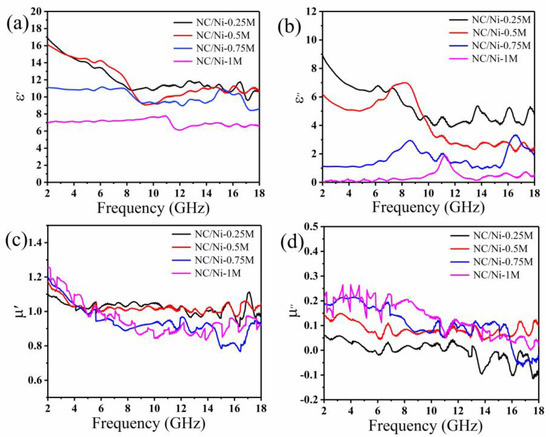
Figure 4.
(a) Real and (b) imaginary parts of the complex permittivity, (c) real and (d) imaginary parts of the complex permeability of NC/Ni in paraffin wax with a mass loading of 50%.
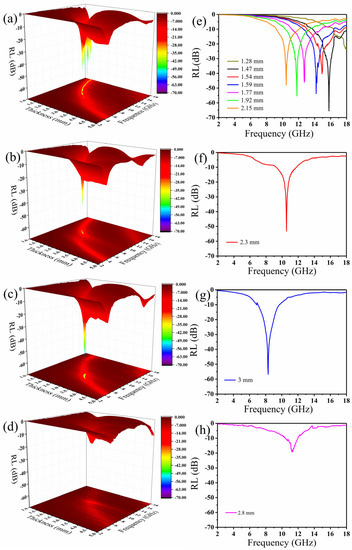
Figure 5.
The 3D representation of RL values of (a) NC/Ni-0.25M, (b) NC/Ni-0.5M, (c) NC/Ni-0.75M and (d) NC/Ni-1M; The 2D representation of RL values of (e) NC/Ni-0.25M, (f) NC/Ni-0.5M, (g) NC/Ni-0.75M and (h) NC/Ni-1M at a mass loading of 50% in paraffin wax.
Typically, the relative complex permittivity and permeability directly affect the properties of microwave absorption. Based on the theory of electromagnetic field, the real parts (ε′ and μ′) of complex permittivity and permeability are related to the electromagnetic energy storage and the imaginary parts (ε″ and μ″) represent the energy dissipation of the materials. In generally, the dielectric and magnetic loss tangent (tan δe = ε″/ε′, tan δm = μ″/μ′) described the dissipation mechanism of the absorber [32]. Figure 6a,b show the results of tan δe and tan δm. The tan δe values roughly satisfy: NC/Ni-0.25M > NC/Ni-0.5M > NC/Ni-0.75M > NC/Ni-1M and the tan δm values satisfy: NC/Ni-0.25M < NC/Ni-0.5M < NC/Ni-0.75M < NC/Ni-1M. However, the difference between the tan δm values was not as significant as that between the tan δe values. Meanwhile, the tan δm values were much lower than the tan δe values, implying the main electromagnetic dissipation mechanism of the NC/Ni compounds was dielectric loss. Further, attenuation constant (a) and impedance matching radio (Zin/Z0) were calculated based on the following equations [33,34]:
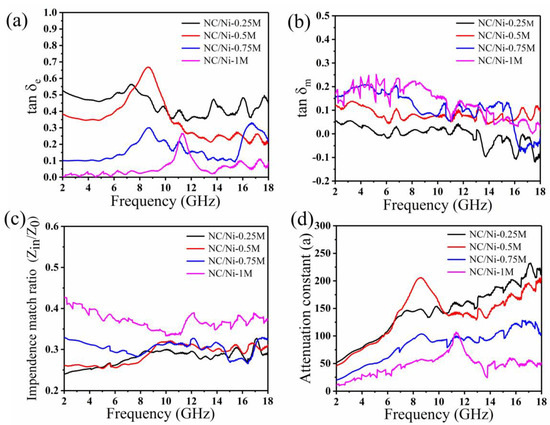
Figure 6.
(a) The dielectric and (b) magnetic loss factors; (c) The radio of impedance matching and (d) attenuation constant of the complex of paraffin wax and NC/Ni with the loading of 50%.
Under ideal conditions, the Zin/Z0 = 1 means the electromagnetic waves all enter the materials without reflection. With the increase of nickel content, the impendence matching ratio of the material became better (Figure 6c), which was ascribed to the compensation of permeability while the attenuation constant dramatically decreased (Figure 6d), resulting in a poor performance of electromagnetic absorption. Despite the poor impedance matching, NC/Ni-0.25M still exhibited excellent electromagnetic absorption characteristics, which could be ascribed to the following points: (1) the numerous dielectric relaxation processes existed in the NC/Ni-0.25M due to the interface and dipoles corresponding to a lot of polar groups as shown in XPS data; (2) the existence of plenty of defects in the NC/Ni-0.25M leaded to dielectric loss, consistent with the Raman spectra; (3) the porous structures of the NC/Ni-0.25M were conducive to enhancing the multiple reflections within the material (conforming to the SEM images), resulting in a strong attenuation; (4) the introduction of Ni nanoparticles has a significant effect on magnetic loss.
4. Conclusions
In summary, the N-doped two-dimension carbon with homogeneous distribution of Ni nanoparticles, a high-performance electromagnetic absorption material, have been synthesized by a simple and efficient microwave-assisted process. The loss mechanism of material was mainly dielectric loss and the introduction of magnetic nanoparticles played an important role in impedance matching. The as-prepared NC/Ni-0.25M showed the RLmin value of −65.5 dB at 15.8 GHz with a thickness of only 1.47 mm and an effective absorption bandwidth of 4.2 GHz. By tuning the Ni concentration to 0.5 M and 0.75 M, the RLmin value of −49.5 dB at 10.6 GHz with the thickness of 2.3 mm and −56.8 dB at 8.3 GHz with the thickness of 3 mm were obtained, respectively.
Author Contributions
Methodology, Y.Z.; Validation, P.L. and S.L.; Formal analysis, H.W. and B.Z. (Bing Zhang); Investigation, P.L. and S.L.; Writing-original draft, P.L.; Writing—review & editing, Y.Z. and B.Z. (Bowen Zhang); Supervision, Y.Z. and K.H.; project administration, Y.Z.; funding acquisition, Y.Z. All authors have read and agreed to the published version of the manuscript.
Funding
This research was funded by the National Natural Science Foundation of China, grant number 61801314, National Natural Science Foundation of China grant number 61731013, Sichuan Province Science and Technology Program grant number 2019YFH0078 and Fundamental Research Funds for the Central Universities of China grant number YJ201703.
Institutional Review Board Statement
Not applicable.
Informed Consent Statement
Not applicable.
Data Availability Statement
Not applicable.
Conflicts of Interest
The authors declare no conflict of interest.
References
- Fan, G.; Jiang, Y.; Hou, C.; Deng, X.; Liu, Z.; Zhang, L.; Zhang, Z.; Fan, R. Extremely facile and green synthesis of magnetic carbon composites drawn from natural bulrush for electromagnetic wave absorbing. J. Alloys Compd. 2020, 835, 155345. [Google Scholar] [CrossRef]
- Liu, P.; Gao, S.; Zhang, G.; Huang, Y.; You, W.; Che, R. Hollow Engineering to Co@N-Doped Carbon Nanocages via Synergistic Protecting-Etching Strategy for Ultrahigh Microwave Absorption. Adv. Funct. Mater. 2021, 31, 2102812. [Google Scholar] [CrossRef]
- Zhou, P.; Wang, X.; Song, Z.; Wang, M.; Huang, W.; Yu, M.; Wang, L.; Zhan, Q. Multi-dimensional ordered mesoporous carbon/silica@Ni composite with hierarchical nanostructure for strong and broadband microwave absorption. Carbon 2021, 176, 209–218. [Google Scholar] [CrossRef]
- Zhu, X.; Qiu, H.; Chen, P.; Chen, G.; Min, W. Graphitic carbon nitride (g-C3N4) in situ polymerization to synthesize MOF-Co@CNTs as efficient electromagnetic microwave absorption materials. Carbon 2021, 176, 530–539. [Google Scholar] [CrossRef]
- Zhu, X.; Dong, Y.; Pan, F.; Xiang, Z.; Liu, Z.; Deng, B.; Zhang, X.; Shi, Z.; Lu, W. Covalent organic framework-derived hollow core-shell Fe/Fe3O4@porous carbon composites with corrosion resistance for lightweight and efficient microwave absorption. Compos. Commun. 2021, 25, 100731. [Google Scholar] [CrossRef]
- Wu, F.; Liu, Z.; Xiu, T.; Zhu, B.; Khan, I.; Liu, P.; Zhang, Q.; Zhang, B. Fabrication of ultralight helical porous carbon fibers with CNTs-confined Ni nanoparticles for enhanced microwave absorption. Compos. Part B-Eng. 2021, 215, 108814. [Google Scholar] [CrossRef]
- Wang, S.; Li, Q.; Hu, K.; Wang, S.; Liu, Q.; Kong, X. A facile synthesis of bare biomass derived holey carbon absorbent for microwave absorption. Appl. Surf. Sci. 2021, 544, 148891. [Google Scholar] [CrossRef]
- Wang, J.; Wu, F.; Cui, Y.; Zhang, A.; Zhang, Q.; Zhang, B. Efficient synthesis of N-doped porous carbon nanoribbon composites with selective microwave absorption performance in common wavebands. Carbon 2021, 175, 164–175. [Google Scholar] [CrossRef]
- Zhao, H.; Cheng, Y.; Zhang, Z.; Zhang, B.; Pei, C.; Fan, F.; Ji, G. Biomass-derived graphene-like porous carbon nanosheets towards ultralight microwave absorption and excellent thermal infrared properties. Carbon 2021, 173, 501–511. [Google Scholar] [CrossRef]
- Tian, Y.; Estevez, D.; Wei, H.; Peng, M.; Zhou, L.; Xu, P.; Wu, C.; Yan, M.; Wang, H.; Peng, H.-X.; et al. Chitosan-derived carbon aerogels with multiscale features for efficient microwave absorption. Chem. Eng. J. 2021, 421, 129781. [Google Scholar] [CrossRef]
- Kuang, D.; Wang, S.; Hou, L.; Luo, H.; Deng, L.; Chen, C.; Song, M.; Mead, J.L.; Huang, H. A comparative study on the dielectric response and microwave absorption performance of FeNi-capped carbon nanotubes and FeNi-cored carbon nanoparticles. Nanotechnology 2021, 32, 105701. [Google Scholar] [CrossRef]
- Chen, J.; Miao, P.; Lin, E.E.; Bai, T.; Smoukov, S.K.; Kong, J. Enhanced microwave absorption performance of light weight N-doped carbon nanoparticles. RSC Adv. 2021, 11, 7954–7960. [Google Scholar] [CrossRef]
- Sunny, V.; Kumar, D.S.; Mohanan, P.; Anantharaman, M.R. Nickel/carbon hybrid nanostructures as microwave absorbers. Mater. Lett. 2010, 64, 1130–1132. [Google Scholar] [CrossRef]
- Zhao, B.; Li, Y.; Guo, X.; Zhang, R.; Zhang, J.; Hou, H.; Ding, T.; Fan, J.; Guo, Z. Enhanced electromagnetic wave absorbing nickel (Oxide)-Carbon nanocomposites. Ceram. Int. 2019, 45, 24474–24486. [Google Scholar] [CrossRef]
- Xu, X.; Ran, F.; Fan, Z.; Lai, H.; Cheng, Z.; Lv, T.; Shao, L.; Liu, Y. Cactus-Inspired Bimetallic Metal-Organic Framework-Derived 1D-2D Hierarchical Co/N-Decorated Carbon Architecture toward Enhanced Electromagnetic Wave Absorbing Performance. ACS Appl. Mater. Interfaces 2019, 11, 13564–13573. [Google Scholar] [CrossRef]
- Yuan, H.; Yan, F.; Li, C.; Zhu, C.; Zhang, X.; Chen, Y. Nickel Nanoparticle Encapsulated in Few-Layer Nitrogen-Doped Graphene Supported by Nitrogen-Doped Graphite Sheets as a High-Performance Electromagnetic Wave Absorbing Material. ACS Appl. Mater. Interfaces 2018, 10, 1399–1407. [Google Scholar] [CrossRef]
- Voiry, D.; Yang, J.; Kupferberg, J.; Fullon, R.; Lee, C.; Jeong, H.Y.; Shin, H.S.; Chhowalla, M. High-quality graphene via microwave reduction of solution-exfoliated graphene oxide. Science 2016, 353, 1413–1416. [Google Scholar] [CrossRef] [PubMed] [Green Version]
- Zhou, S.; Huang, Y.; Xu, L.; Zheng, W. Microwave-assisted synthesis of graphene-NiS/Ni3S2 composites for enhanced microwave absorption behaviors through a sulfuration method. Ceram. Int. 2018, 44, 21786–21793. [Google Scholar] [CrossRef]
- Elhassan, A.; Abdalla, I.; Yu, J.; Li, Z.; Ding, B. Microwave-assisted fabrication of sea cucumber-like hollow structured composite for high-performance electromagnetic wave absorption. Chem. Eng. J. 2020, 392, 123646. [Google Scholar] [CrossRef]
- Zhou, Y.; Li, J.; Yang, Y.; Luo, B.; Zhang, X.; Fong, E.; Chu, W.; Huang, K. Unique 3D flower-on-sheet nanostructure of NiCo LDHs: Controllable microwave-assisted synthesis and its application for advanced supercapacitors. J. Alloys Compd. 2019, 788, 1029–1036. [Google Scholar] [CrossRef]
- Xie, X.; Wang, H.; Zhou, Y.; Huang, K. One-step self-triggered microwave-assisted fabrication of NiCo/graphene for microwave attenuation. J. Mater. Sci.-Mater. Electron. 2020, 31, 12467–12475. [Google Scholar] [CrossRef]
- Sun, Q.; Zhang, X.; Liu, R.; Shen, S.; Wu, F.; Xie, A. Nickel-assisted synthesis of magnetic bamboo-shaped N-doped carbon nanostructure for excellent microwaves absorption. Synth. Met. 2021, 272, 116644. [Google Scholar] [CrossRef]
- Li, C.; Sui, J.; Zhang, Z.; Jiang, X.; Zhang, Z.; Yu, L. Microwave-assisted synthesis of tremella-like NiCo/C composites for efficient broadband electromagnetic wave absorption at 2–40 GHz. Chem. Eng. J. 2019, 375, 122017. [Google Scholar] [CrossRef]
- Zhang, Q.; Zhou, Y.; Xu, F.; Lin, H.; Yan, Y.; Rui, K.; Zhang, C.; Wang, Q.; Ma, Z.; Zhang, Y.; et al. Topochemical Synthesis of 2D Carbon Hybrids through Self-Boosting Catalytic Carbonization of a Metal-Polymer Framework. Angew. Chem. Int. Ed. 2018, 57, 16436–16441. [Google Scholar] [CrossRef]
- Wang, J.; Wang, Q.; Wang, W.; Li, P.; Zhao, Y.; Zhai, J.; Zhao, W.; Zhang, H.; Yun, J.; Zhang, Z.; et al. Hollow Ni/C microsphere@graphene foam with dual-spatial and porous structure on the microwave absorbing performance. J. Alloys Compd. 2021, 873, 159811. [Google Scholar] [CrossRef]
- Liu, D.; Du, Y.; Xu, P.; Wang, F.; Wang, Y.; Cui, L.; Zhao, H.; Han, X. Rationally designed hierarchical N-doped carbon nanotubes wrapping waxberry-like Ni@C microspheres for efficient microwave absorption. J. Mater. Chem. A 2021, 9, 5086–5096. [Google Scholar] [CrossRef]
- Min, W.; Liu, D.; Chen, P.; Zhu, X.; Qiu, H. Well-Dispersed Ni Nanoparticles Loaded on Uniform Hollow N-Doped Carbon Spheres for Outstanding Microwave Absorption Performance at a Low Filler Loading. J. Electron. Mater. 2021, 50, 4866–4879. [Google Scholar] [CrossRef]
- Wang, K.; Chen, Y.; Tian, R.; Li, H.; Zhou, Y.; Duan, H.; Liu, H. Porous Co-C Core-Shell Nanocomposites Derived from Co-MOF-74 with Enhanced Electromagnetic Wave Absorption Performance. ACS Appl. Mater. Interfaces 2018, 10, 11333–11342. [Google Scholar] [CrossRef]
- Yang, P.; Zhao, X.; Liu, Y.; Lai, X. Preparation and electromagnetic wave absorption properties of hollow Co, Fe@air@Co and Fe@Co nanoparticles. Adv. Powder Technol. 2018, 29, 289–295. [Google Scholar] [CrossRef]
- Qiu, J.; Wu, X.; Qiu, T. High electromagnetic wave absorbing performance of activated hollow carbon fibers decorated with CNTs and Ni nanoparticles. Ceram. Int. 2016, 42, 5278–5285. [Google Scholar] [CrossRef]
- Fu, C.; Huang, H.; Li, X.; Xiang, F.; Cheng, Y.; Zhang, J. Adjusting the microwave absorption properties of carbon nanotube composites with ferrocene by annealing under different conditions. J. Alloys Compd. 2020, 845, 156226. [Google Scholar] [CrossRef]
- Goel, S.; Garg, A.; Baskey, H.B.; Pandey, M.K.; Tyagi, S. Studies on dielectric and magnetic properties of barium hexaferrite and bio-waste derived activated carbon composites for X-band microwave absorption. J. Alloys Compd. 2021, 875, 160028. [Google Scholar] [CrossRef]
- Qin, Y.; Wang, M.; Gao, W.; Liang, S. Rationally designed structure of mesoporous carbon hollow microspheres to acquire excellent microwave absorption performance. RSC Adv. 2021, 11, 14787–14795. [Google Scholar] [CrossRef]
- Zhang, X.; Qi, S.; Zhao, Y.; Wang, L.; Fu, J.; Yu, M. Synthesis and microwave absorption properties of Fe@carbon fibers. RSC Adv. 2020, 10, 32561–32568. [Google Scholar] [CrossRef]
Publisher’s Note: MDPI stays neutral with regard to jurisdictional claims in published maps and institutional affiliations. |
© 2021 by the authors. Licensee MDPI, Basel, Switzerland. This article is an open access article distributed under the terms and conditions of the Creative Commons Attribution (CC BY) license (https://creativecommons.org/licenses/by/4.0/).